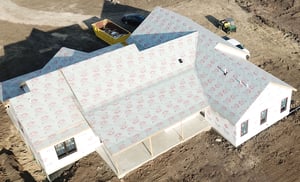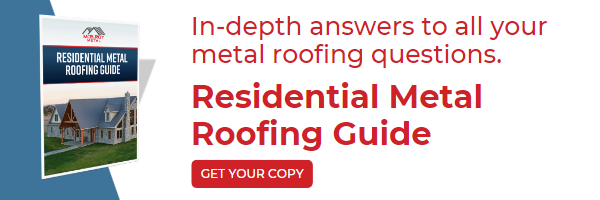Every year, more and more homeowners opt for a metal roofing system. With a lifespan of 40+ years, energy efficiency, and low maintenance costs, it's tough to beat the value that metal roofing provides, especially when you consider that long-term metal roofing costs less than shingles.
 One of the most important factors with your new metal roof is finding a quality contractor with experience installing metal roofing. Like conventional shingle roofs, faulty installations and poor workmanship can lead to performance (such as leaks) and aesthetic issues.
One of the most important factors with your new metal roof is finding a quality contractor with experience installing metal roofing. Like conventional shingle roofs, faulty installations and poor workmanship can lead to performance (such as leaks) and aesthetic issues.
A roofing contractor with experience and expertise in metal roofing can also help you select the best metal roofing system.
Once you have hired your roofing contractor, they can answer questions about your metal roof project. In the meantime, here are some general thoughts about what you can expect with a typical metal roof installation.
Metal Roof Installation Methods
Metal roof installations are either new construction or retrofit.

New Construction
Metal panels may (or may not) offer spanning capabilities depending on the panel profile selected. Panels without spanning abilities require the application of a plywood deck over the trusses or rafters before the metal panels can be installed. Panels like our Meridian require a plywood deck and represent a great option for residential applications.
Once the plywood is installed, the decking material is then covered with an underlayment material. While underlayments help shed water during construction, the building envelope is not considered watertight until the final roofing material is installed. The same holds true for shingle applications.
Consequently, on new construction projects, finish trades such as drywallers never start their work until after the final roofing system is installed.
Recover/Overlay
For retrofit projects, the roofing contractor has two primary options - recover/overlay or remove and replace.
The recover/overlay option involves installing the new roof on top of the existing roof. While this isn't always a viable option (more on that below), when possible, recovering the existing roof eliminates the cost and labor of removing and disposing of the existing roof and related components.
Beyond the obvious cost savings, since shingles take 300 years to decompose, leaving the shingles in place also helps to reduce landfill pressures.

When considering whether to leave shingles in place, it is important to remember that steel panels can act like a mirror and telegraph deck inconsistencies and curled shingles through the new metal panels.
On some projects, recover/overlay is not a viable option, so the contractor will recommend a remove and replace approach. As the name implies, this approach involves removing all roofing materials to the original plywood deck and installing new metal panels over the decking.
Contributing factors in this decision are many, but two common reasons to remove and replace are as follows:
- Local building codes often dictate if a removal and replacement are required. Most jurisdictions allow recover applications for either one or two existing layers of shingles. If the number of shingle layers exceeds code requirements, it will be necessary to remove the shingle roof before installation of the new metal roofing.
- If the existing roof leaks, water-damaged wood decking may require replacement. Soft (or rotten in extreme cases) decking should never be covered with new roofing material. Instead, compromised wood decking should be immediately replaced. After a thorough inspection, your roofing contractor should be able to provide good direction on the possibility of decking material replacement.
All things being equal, tear-off, demolition, and decking repair all increase material and labor costs. When deemed necessary, those steps should be taken; however, in many cases, leaving the existing roof in place helps reduce overall cost and installation time without sacrificing expected performance.
Metal Roof Installation Components
The following represent the core components of any metal roof installation project.
Substrate
Refers to the material used to cover the rafters and joists. Typically, this can be plywood, planking, or OSB (Oriented Strand Board) attached to the top of the roof framing members to create the roof surface for the underlayment and metal panel attachment.
Underlayment
 Most metal roofing contractors utilize synthetic underlayments, which offer many benefits compared to the early generation felt paper options.
Most metal roofing contractors utilize synthetic underlayments, which offer many benefits compared to the early generation felt paper options.
Synthetic underlayments are easier to install, offer improved durability, and can be left exposed to nature’s elements for longer.
Give "What's the Best Underlayment for a Metal Roof" to learn more about metal roofing underlayment options.
Metal Roof Panels
Metal roof panels come in various sizes, profiles, colors, and budgets. You can even purchase metal panels that look like shingles!
Generally speaking, exposed fastener products represent the most economical panel style to purchase and install; however, they can require fastener replacement after 20-25 years. While fastener replacement is not expensive nor a difficult task, some homeowners prefer concealed fastener (also called standing seam) style roofing panels to reduce the opportunity for leaks and maintenance.
Your metal roof supplier or contractor can help you sort through all of the available options. Or check out the resources below:
- Visualizer Tool - You can upload a photo of your home if you'd like!
- Photo Gallery
- Panel Selector Tool
Fasteners and Clips
Depending on the type of metal panel you select, your roofing contractor will use clips and/or fasteners to attach the roofing panels to the decking.
 Trim and Flashing
Trim and Flashing
Trim and flashing refer to the components that are installed at the intersections and terminations of the metal roofing system to seal the roof and prevent water from entering the roofing system and building envelope.
Sealants and Caulking
Butyl tapes and sealants are used for metal-to-metal connections, such as laps or junctions that intersect trims and panels.
The sealant must adhere to painted metal surfaces and provide some elasticity (for movement) as the metal expands and contracts with the changing weather.
Check out this Meridian installation video to see many of the components used when installing a metal roof.
Job Site Requirements
Every job site is different, but here are the key points to consider to ensure your new metal roof installation goes as smoothly as possible.
Accessibility
Establish a flat area for material storage, vehicle parking, and a dumpster (if needed) for your contractor and their installers.
Depending on your roof, the installers will need clear access on all sides of the building to position and install the panels and trim.
Power Supply
Your contractor will need a power supply for their cutting and fastening tools. To avoid tripping breakers all day, have the installers use different outlets to power their tools and equipment.
Some contractors provide a generator for their installers to use.
Safety Issues
Safety should always be a high priority, especially when occupants are in and around the building during the metal roof installation.
Metal roof panels and trim have sharp edges, so only the installers should handle them.
Other Installation Resources
For instance, all of our installation manuals are available for download on our Downloads page. The installation manuals provide general product notes, details showing suggested guidelines for proven methods of construction, and contact information for our technical service department.
These manuals do not, nor are they intended to, cover all building requirements, designs, installation methods, or codes. Again, the best resource available to you is an experienced contractor.
You can learn more by visiting our metal roof resources page if you still have questions about a metal roof installation. Here you can download different metal roof guides, access our project visualizer, or watch project videos.
About McElroy Metal
Since 1963, McElroy Metal has served the construction industry with quality products and excellent customer service. The employee-owned components manufacturer is headquartered in Bossier City, La., and has 14 manufacturing facilities across the United States. Quality, service and performance have been the cornerstone of McElroy Metal’s business philosophy and have contributed to the success of the company through the years. As a preferred service provider, these values will continue to be at the forefront of McElroy Metal’s model along with a strong focus on the customer.






.png?width=767&name=Metal%20Roofing%20for%20Event%20Centers,%20Arenas%20%20&%20Sports%20Facilities%20(1).png)



Comments on this article:
Scroll down to the bottom to submit a comment and join the conversation. Need help or have a question? Please contact us. Looking for a distributor or contractor? Please click here to get started.